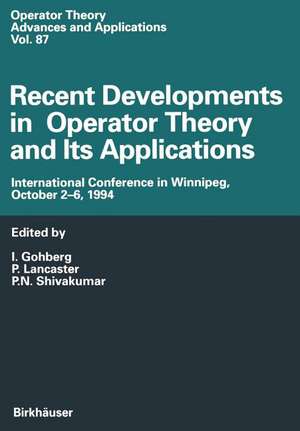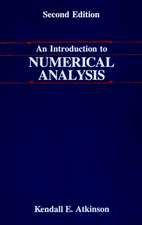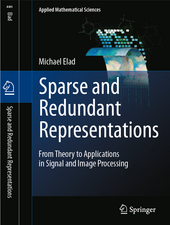Recent Developments in Operator Theory and Its Applications: International Conference in Winnipeg, October 2–6, 1994: Operator Theory: Advances and Applications, cartea 87
Editat de I. Gohberg, P. Lancaster, P.N. Shivakumaren Limba Engleză Paperback – 8 oct 2011
Din seria Operator Theory: Advances and Applications
- 18%
 Preț: 890.54 lei
Preț: 890.54 lei - 20%
 Preț: 574.08 lei
Preț: 574.08 lei - 18%
 Preț: 1127.60 lei
Preț: 1127.60 lei - 15%
 Preț: 643.34 lei
Preț: 643.34 lei - 18%
 Preț: 961.55 lei
Preț: 961.55 lei -
 Preț: 395.63 lei
Preț: 395.63 lei - 15%
 Preț: 648.05 lei
Preț: 648.05 lei - 18%
 Preț: 737.71 lei
Preț: 737.71 lei - 15%
 Preț: 653.14 lei
Preț: 653.14 lei -
 Preț: 384.48 lei
Preț: 384.48 lei - 15%
 Preț: 644.82 lei
Preț: 644.82 lei - 15%
 Preț: 645.79 lei
Preț: 645.79 lei -
 Preț: 402.00 lei
Preț: 402.00 lei - 15%
 Preț: 650.04 lei
Preț: 650.04 lei - 15%
 Preț: 660.83 lei
Preț: 660.83 lei - 15%
 Preț: 639.08 lei
Preț: 639.08 lei - 18%
 Preț: 940.09 lei
Preț: 940.09 lei - 15%
 Preț: 648.05 lei
Preț: 648.05 lei -
 Preț: 388.90 lei
Preț: 388.90 lei - 18%
 Preț: 728.11 lei
Preț: 728.11 lei - 20%
 Preț: 574.08 lei
Preț: 574.08 lei - 15%
 Preț: 645.79 lei
Preț: 645.79 lei - 18%
 Preț: 1128.89 lei
Preț: 1128.89 lei - 15%
 Preț: 646.11 lei
Preț: 646.11 lei - 15%
 Preț: 648.89 lei
Preț: 648.89 lei - 18%
 Preț: 745.33 lei
Preț: 745.33 lei - 18%
 Preț: 1124.47 lei
Preț: 1124.47 lei - 15%
 Preț: 647.08 lei
Preț: 647.08 lei - 15%
 Preț: 662.62 lei
Preț: 662.62 lei -
 Preț: 392.75 lei
Preț: 392.75 lei - 18%
 Preț: 960.96 lei
Preț: 960.96 lei - 15%
 Preț: 646.43 lei
Preț: 646.43 lei - 18%
 Preț: 738.37 lei
Preț: 738.37 lei
Preț: 400.65 lei
Nou
Puncte Express: 601
Preț estimativ în valută:
76.67€ • 80.41$ • 63.82£
76.67€ • 80.41$ • 63.82£
Carte tipărită la comandă
Livrare economică 01-15 aprilie
Preluare comenzi: 021 569.72.76
Specificații
ISBN-13: 9783034898782
ISBN-10: 3034898789
Pagini: 452
Ilustrații: XII, 436 p.
Dimensiuni: 170 x 244 x 24 mm
Greutate: 0.71 kg
Ediția:Softcover reprint of the original 1st ed. 1996
Editura: Birkhäuser Basel
Colecția Birkhäuser
Seria Operator Theory: Advances and Applications
Locul publicării:Basel, Switzerland
ISBN-10: 3034898789
Pagini: 452
Ilustrații: XII, 436 p.
Dimensiuni: 170 x 244 x 24 mm
Greutate: 0.71 kg
Ediția:Softcover reprint of the original 1st ed. 1996
Editura: Birkhäuser Basel
Colecția Birkhäuser
Seria Operator Theory: Advances and Applications
Locul publicării:Basel, Switzerland
Public țintă
ResearchCuprins
Inverse scattering problem for continuous transmission lines with rational reflection coefficient function.- 1. Introduction.- 2. Some results on differential expressions.- 3. The reflection coefficient function.- 4. The rational case.- References.- The band method and the Grassmannian approach for completion and extension problems.- 1. Introduction.- 2. The Grassmannian approach.- 3. Proofs of theorems 2.2 and 2.3.- 4. The Caratheodory and Nehari extension problems.- 5. Operator matrix extension problems.- References.- Polar decompositions in finite dimensional indefinite scalar product spaces: Special cases and applications.- 1. Introduction.- 2. H-contractive matrices.- 3. H-plus matrices.- 4. Indefinite scalar products with only one positive square.- 5. Polar decompositions with special unitary factors.- 6. Applications: Linear optics.- References.- Positive differential operators in Krein space L2(R).- 1. Abstract results.- 2. Differential operators with constant coefficients.- 3. Half-range completeness.- References.- Elliptic problems involving an indefinite weight function.- 1. Introduction.- 2. Preliminaries.- 3. Main results.- 4. Examples.- References.- The KDV hierarchy and associated trace formulas.- 1. Introduction.- 2. The KDV hierarchy, recursion relations, and hyperelliptic curves.- 3. The stationary formalism.- 4. The time-dependent formalism.- 5. General trace formulas.- Appendix A. Hyperelliptic curves of the KDV-type and theta functions.- Appendix B. An explicit illustration of the Riemann-Roch theorem.- References.- On spectral properties of Schrödinger-type operator with complex potential.- 1. General perturbation results.- 2. Application to the Schrodinger-type operator.- Appendix 1. Proof of Theorem 1.- Appendix 2. Proof of Theorem 6.- Appendix3. The subordination condition.- References.- Coalgebras and spectral theory in one and several parameters.- 1. Introduction.- 2. Coalgebras and comodules.- 3. The coalgebra dual of a polynomial algebra.- 4. The primary decomposition theorem.- 5. Monic matrix polynomials.- 6. Several commuting maps.- 7. Multiparameter systems.- References.- Destabilization of infinite-dimensional time-varying systems via dynamical output feedback.- 1. Introduction.- 2. Notation and fundamental results.- 3. System description.- 4. Problem formulation.- 5. Destabilization results.- References.- Perturbations of G-selfadjoint operators and operator polynomials with real spectrum.- 1. Introduction.- 2. Perturbations of finite rank.- 3. Small and compact perturbations.- 4. Applications to operator polynomials.- 5. A factorization theorem in the monic case.- 6. Differential equations with stably bounded solutions.- 7. The case of noninvertible leading coefficient.- References.- Definitizable G-unitary operators and their applications to operator polynomials.- 1. Introduction.- 2. Preliminary definitions and results.- 3. Compact perturbations.- 4. Operator polynomials quasihyperbolic on T.- 5. Other charcterizations of QHP on T.- References.- System theoretic aspects of completely symmetric systems.- 1. Introduction.- 2. Discrete time systems.- 3. Continuous-time systems.- References.- Contractive completion of block matrices and its application to H? control of periodic systems.- 1. Introduction.- 2. H? periodic control and lifting.- 3. Matrix contractive completion.- 4. All H? suboptimal periodic controllers.- 5. Concluding remarks.- Appendix: Proof of Theorem 1.- References.- Spline approximation methods for Wiener-Hopf operators.- 1. Introduction.- 2. Technical preliminaries.- 3. Analgebra of approximation sequences for Wiener-Hopf operators.- 4. Approximation methods for composed operators.- References.- Inertia conditions for the minimization of quadratic forms in indefinite metric spaces.- 1. Introduction.- 2. An inertia result for linear transformations.- 3. The indefinite-weighted least-squares problem.- 4. The equivalent estimation problem.- 5. Relations between the IWLS and EE problems.- 6. Incorporating state-space structure.- 7. A recursive IWLS problem in the presence of state-space structure.- 8. An application to H?-filtering.- 9. An application to robust adaptive filters.- 10. An application to total least-squares methods.- 11. Concluding remarks.- References.- Bounds for the width of the instability intervals in the Mathieu equation.- 1. Introduction.- 2. Preliminaries.- References.- Operator pencils arising in elasticity and hydrodynamics: The instability index formula.- 1. Classes of unbounded operator pencils.- 2. Root subspaces of linear dissipative pencils and their properties.- 3. Quadratic dissipative pencils and the instability index formula.- 4. Applications.- References.- Toeplitz-like operators and their finite sections.- 1. Introduction.- 2. The main results.- 3. Proofs.- References.- Spectral representations and spectral functions of symmetric operators.- 0. Introduction.- 1. Spectral representations of linear operators.- 2. Selfadjoint extension in a larger Hilbert space.- 3. The generalized spectral function of a symmetric operator and the corresponding spectral transformation.- 4. Generalized resolvents of a symmetric operator.- References.- Hankel type operators, Bourgain algebras, and isometries.- 1. Hankel type operators and Bourgain algebras.- 2. Complete continuity of Hankel type operators and isometries.- 3.Biholomorphic equivalence and Bourgain algebras.- References.- Effective computation of operators defined by line integrals.- 1. Introduction.- 2. Numerical procedure.- 3. Modified Gaussian quadratures.- 4. Piecewise modified Guassian quadrature on an interval.- 5. The calculation of line integrals.- 6. Extension for the calculation of operators defined by Cauchy principal value integrals.- References.


















